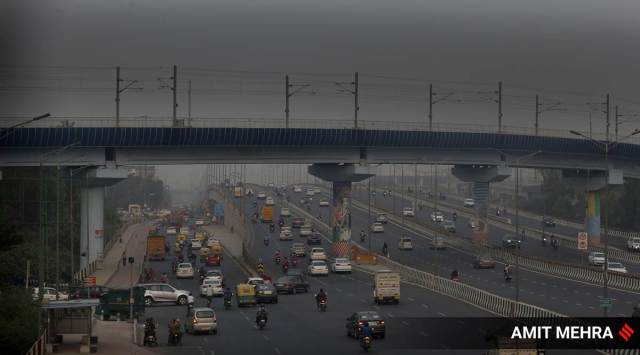- India
- International
Toxic haze envelops Delhi as air quality plummets to severe range
The 24-hour average AQI settled at 395 in the very poor category, five points below the severe range, as per data from the Central Pollution Control Board (CPCB).
 The city had seen the minimum temperature fall to 12.5 degrees Celsius, the lowest in October in 26 years.
The city had seen the minimum temperature fall to 12.5 degrees Celsius, the lowest in October in 26 years.Stubble burning, local emissions and unfavourable weather conditions pushed Delhi’s overall air quality index into the severe category (AQI more than 400) for a few hours on Thursday — the first time it has entered this range this season.
The 24-hour average AQI settled at 395 in the very poor category, five points below the severe range, as per data from the Central Pollution Control Board (CPCB).
A Delhi government official said, “Poor weather conditions, mainly low wind speed near the surface, started Wednesday afternoon and improved by noon Thursday. We were experiencing very low surface-level wind speed, but at the same time, wind speed in the upper levels was enough to bring pollutants from stubble burning states. Since wind speed near the surface was low, pollutants were not getting dispersed.”
At 36%, pollutants emitted from stubble burning in Punjab, Haryana and UP had the highest share in Delhi’s air Thursday ever since the count began October 8 onwards, as per the Centre’s System of Air Quality and Weather Forecasting and Research (SAFAR).
Delhi chief secretary also held a meeting Thursday afternoon, officials said, in which directions were given to district magistrates, MCDs and other departments concerned to take all possible steps to control local emissions within the city. Officials said measures including mechanised sweeping and water sprinkling on roads have been intensified in air pollution hotspots and across the city.

The AQI remained in the severe range between 11 am and 2 pm in at least 14-17 of 35 air quality monitoring stations. The worst affected areas as of 2 pm were Bawana (449), Jahangirpuri (439), Wazirpur (436) and Alipur (433). Severe air quality affects healthy population and also seriously impacts those with pre-existing medical conditions, as per the CPCB.
Concentration of PM 10 and PM 2.5 peaked at 420 and 230 µg/m3 at 10 am in Delhi-NCR, nearly four times above their 24-hour exposure limit of 100 and 60 µg/m3, as per CPCB data.
The rise in stubble burning’s contribution to PM 2.5 to Delhi’s air was recorded a day after air quality forecasting agencies noted close to 3,000 fire counts in Haryana, Punjab and UP.
Haryana recorded 114 fire counts Wednesday, as per data from the state pollution control board, while Punjab recorded 2,989 fire counts, as per data from the Punjab Remote Sensing Centre. So far, Haryana has recorded 4,837 fire counts since September 25 and Punjab has recorded 21,636 since September 21.
A bulletin from SAFAR Thursday said, “Increased surface wind speed and better ventilation conditions are likely to significantly improve the (air quality) situation of Delhi by October 31.”
A forecast from the Ministry of Earth Science’s Air Quality Early Warning System (EWS) for Delhi said the AQI is likely to remain very poor Friday and improve within the very poor category by Saturday in Delhi-NCR.
Apr 18: Latest News
- 01
- 02
- 03
- 04
- 05





























